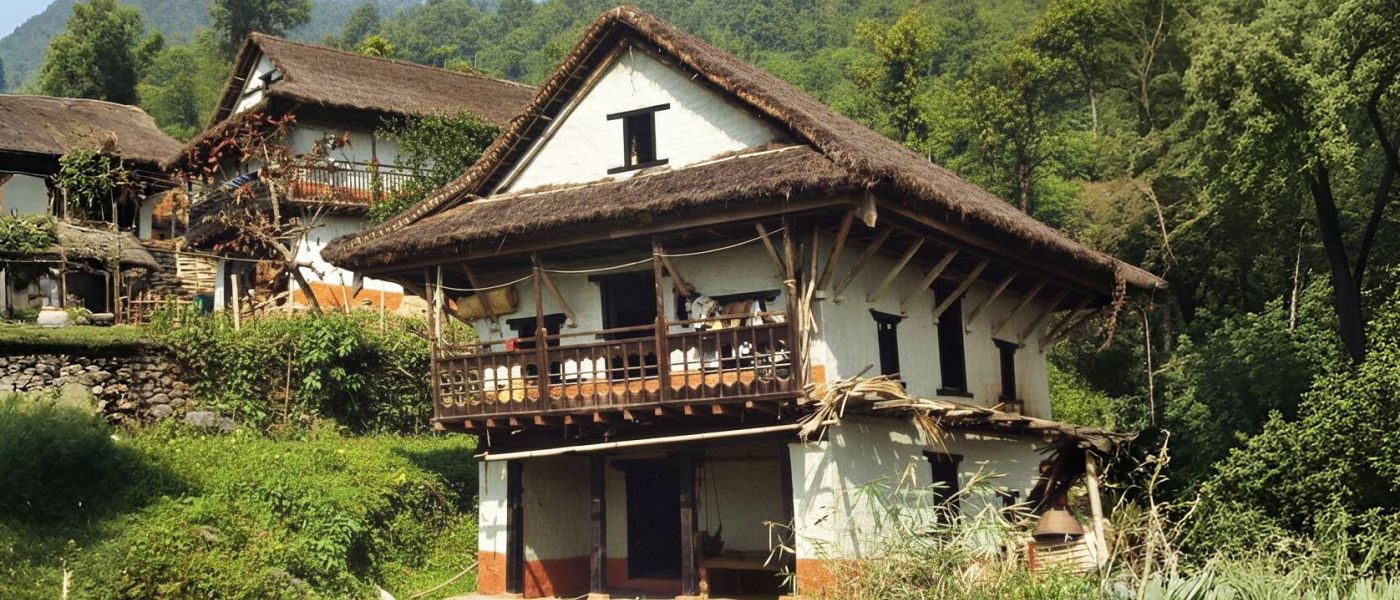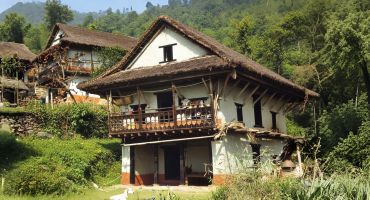Indigenous architecture across the Himalayas exhibits striking variety depending on the community that created it. The climate, environment and geographic region are factors intimately tied to indigenous designs. The typical Limbu dwelling is a two-storey thatched house built from timber, bamboo, stone, mud and straw, which are all locally sourced items. Its steeply pitched roof and thick thatch are designed to avoid monsoon rain and withstand winter snowfall, and the mud walls effectively regulate temperature and provide durability. Designed with careful attention to natural features, such as rivers and slopes, a traditional Limbu house demonstrates both practical concerns and spiritual beliefs.
At the centre of the Limbu house, both figuratively and physically, stands the central pillar, the Hang Sitlang or Murum Sitlang or Muring Sitlam. This pillar serves as the axis around which domestic life, the memory of ancestors, and the unseen spiritual realms converge. It is regarded, in Limbu spiritual concept, a sacred fulcrum that anchors the household in both material and cosmological terms. As Philip Sagant observed in his ethnographic study of Limbu architecture and ritual:
“The central post of the Limbu house is more than an architectural necessity; it is the axis around which the life of the family, the memory of ancestors, and the communication with the spirits revolve” (L’Homme et la Maison chez les Limbu du Népal oriental).

The Hang Sitlang imparts an immaterial dimension to the house. Viewed in this light, the dwelling, and the symbolism related to it provide a conceptual basis, giving us the right perspective to interpret the meaning of Limbu cultural life and, especially, to comprehend the exact consequences of spiritual and symbolic nature.
As mentioned earlier, this pillar, in Limbu worldview, represents the repository of ancestral memory. Although as a medium that disengages the house as a physical dimension from the subterranean realm of chthonic forces, Hang Sitlang, through ritual offerings, and performing sacrifices, also acts as a sacred stage upon which ancestral remembrance is enacted.
Additionally, within the wider framework of Mundhum (the oral, ritual, and mythological corpus of the Limbu), the Hang Sitlang serves as both ritual pivot and cosmological mnemonic, allowing family elders and Shamans to enact, through chants and ritualized movement, the structure of the universe itself.
As Sagant notes,
“The shaman’s chant retraces the world’s structure; the house itself becomes the visible form of the cosmos. The post at the centre is the pivot of this world, joining earth to sky” (Sagant, 1985, “With Head Held High: The House, Ritual and Politics in East Nepal”)
The erection of the Hang Sitlang generally coincides with the construction of a new house or the major renovation of an old one. The ritual process begins with the preparation of the site, where a pit is dug at the centre of the house and the pillar is firmly set into the ground. Before installation, the pillar is ritually sanctified by binding it with cotton threads at the top, middle, and bottom, and by sprinkling it with rice grains. A pig is then sacrificed, and its blood poured at the base of the post to purify the contact between the house and the earth. The officiating Shaman invokes the protective deity Okwanama, the “earth-supporter,” and requests protection from illness and misfortune for the household.
In a foundational text, Kiratologist Iman S. Chemjong (1948) outlines the ceremony of erecting the main post:
“When the site of a house is being dug … its centre portion should be dug, a deep hole should be made and a very big, strong and high wooden pillar should be fixed there. … This main pillar of the house should be called, ‘Hang Sitlang’. Before the plantation of this main pillar, the top, the middle and the bottom of it should be bound with a cotton thread and some grains of rice should be sprinkled over them … A pig should be killed and its blood should be sprinkled at the bottom of the post as an offering to the deity Okwanama.”
Once the central post has been installed, the family holds a house-warming celebration to which relatives and neighbors contribute offerings of rice, coins, and beer. A communal feast follows, during which the ritual known as Heem-gey is performed. This is when dancers circle the post three times before dancing throughout the night. In marriage ceremonies and other major rites, Chyabrung or Ke Lang drummers also dance around the main pillar. Descriptive accounts note that during such occasions, the dancers move in repeated circuits around the post.The detailed sequence of actions involved in the installation of the Hang Sitlang reveals that it is far more than a technical operation. The rite constitutes a performative fusion of social and architectural dimensions.
For the Limbu, through the symbolic geography that Hang Sitlang represents, the house itself is also understood as a feminine sacred space associated with Yuma, the primordial mother-goddess of the Limbu. Much like her, the house too represents protection, fertility, refuge, and ancestral continuity. In this framework, the pillar becomes the point where the deity and the domestic sphere converge.
During rituals dedicated to protective deities such as Nahangma, it is treated as the centre of both the ritual field and the physical world of the household. In these ways, the Hang Sitlang successfully transforms from a structural support into a cosmological signifier as a tangible link between protective spirits and their realm.
The ritual significance of the Hang Sitlang, the main pillar of the house, lies deep within the oral universe of the Mundhum. A Mundhum story recounts the moment when the very first house was raised upon the earth by Lokphedemba and Hangphademba.
When the Limbu ancestors built the first house it did not have peace as termites, and malevolent forces gathered around it. They threatened to hollow the wood and bring down the structure. To protect this fragile beginning, the ancestral drummers Laden Hangba and Phungden Hangba stepped forward. They lifted their Ke drums and began to dance around the central pillar. With each rotation, they struck at the swarm of invisible dangers, and with each beat, they sanctified the pillar. Their dance, an act of defense, was an effort to protect the wooden centre of the house, to drive away destructive spirits, and to shield the structure from calamities of wind, fire, and trembling earth. The house endured because the pillar was blessed, and the ground beneath it was made firm through ritual movement and sound.
This primordial act became the template for later generations. In any new house, the Ke Lang or Chyabrung dance is still performed around the main post, echoing the movements of those first drummers and renewing the protective bond between pillar, household, and ancestral memory. In marriage ceremonies, dancers circle the pillar four times, and offer blessings for stability and long conjugal life. Their movements recall the original moment when the house was first defended and the pillar first empowered. Thus, even if the Hang Sitlang rarely appears as a central character in extended mythic narratives, the Mundhum preserves its presence as a sacred centre. Through this pillar, the household is bound to the earliest story of shelter, protection, and the enduring relationship between humans and the unseen forces that move through the world.

As modernization and new architectural practices have evolved, the installation and meaning of the Hang Sitlang have begun to face pressures. Traditional houses and a clearly visible central pillar are now rare, and many new structures adopt modern designs in which the pillar appears only faintly or is replaced entirely. In some households, the post is erected only symbolically or the full ritual sequence, such as thread-binding, sacrificial offerings, or the protective dance around the pillar, is abbreviated or omitted, leaving younger generations increasingly unfamiliar with its cosmological role as the household’s axis and ritual centre.
Despite these changes, the practice endures in many rural areas of eastern Nepal, where new houses still include the pillar and old houses are being preserved. For traditional Limbus, Hang Sitlang continues to be the ritual heart of the house, the axis of cosmos and family, the stage of social and spiritual life. In its erection, connection, sacrifice, dance and invocation, the household is transformed into a sacred space. As the Limbu community navigates the 21st century, the pillar remains a powerful reminder of the continuity of indigenous traditions.





Leave a Reply